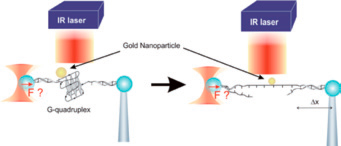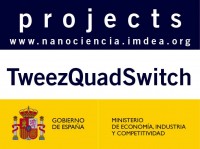TweezQuadSwitch G-quadruplex as a nanoheater-induced molecular switch demonstrated by optical tweezers
Dr. J. Ricardo Arias
-
Funding : Ministerio de Economía y Competitividad. Programa Excelencia 2013-2016. Explora Ciencia 2013. MAT-49455-EXP
-
Duration: 2014 - 2015
-
24 months
G-quadruplexes are nucleic acid sequences rich in guanines (G) that form four-stranded structures. Control over the mechanics of folding and unfolding of the G-quadruplex structure has become an attractive goal in cancer research. There are several metallic complexes known to stabilize G-quaruplexes. They block the unfolding of the structure inhibiting the activity of telomerase.
We aim to use gold NPs as G-quadruplex folding/unfolding switches upon laser irradiation. We aim to demonstrate by using optical tweezers that we can control the conformation of a G-quadruplex by means of the heat released by a nanostructure. To test this prospect, we will attach a single gold NP to a (Pt-)G-quadruplex to attain a highly specific control on its folding state by using a laser beam. Then, we will use optical tweezers to hold a single G-quadruplex-NP construction to obtain a clear-cut detection of the folding/unfolding mechanical force signal.
Positive results will set the basis for the development of active nanoswitches that combine nucleic acids and absorptive NPs with unprecedented control by physical means. The proposed nanoactuators could be remotely controlled for therapeutic uses.

Central assay in TweezQuadSwitch: a G-quadruplex doped with a gold NP is illuminated in the infrared by a focused laser beam (left), exciting heat from the NP thus generating the mechanical unfolding of the nucleic acid structure (right) at a critical force F measured by the optical trap.





